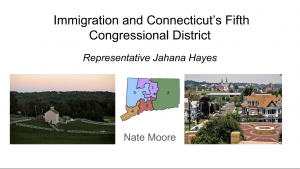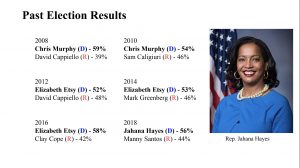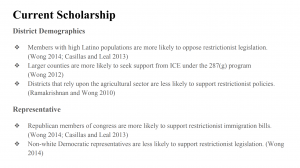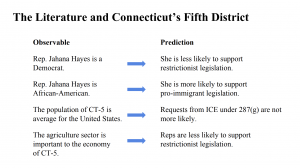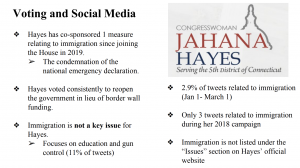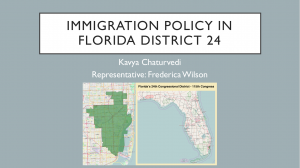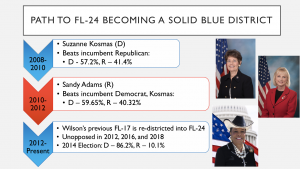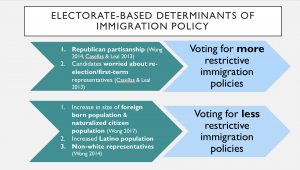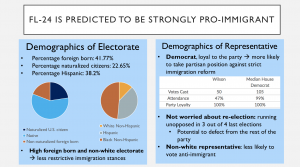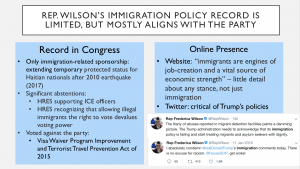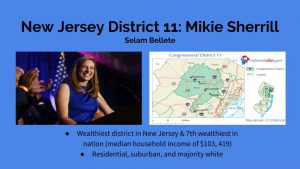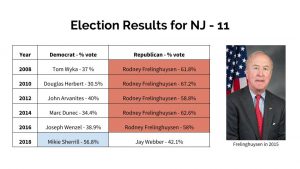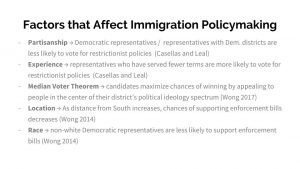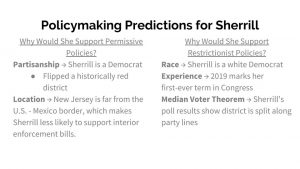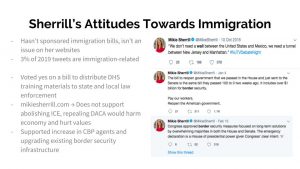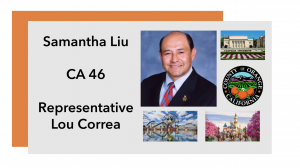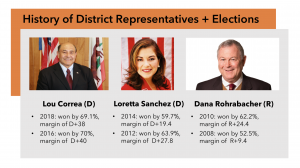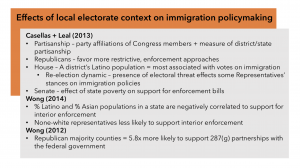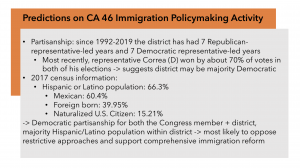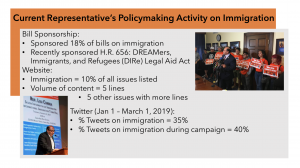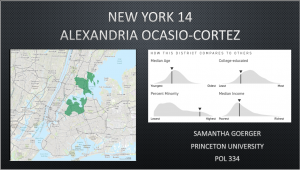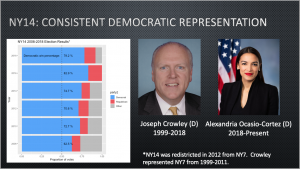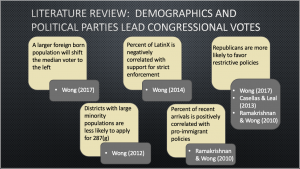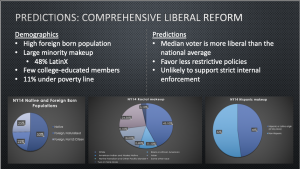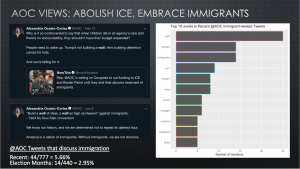Link to Slides
Title Slide: In this slide, I’ve included a picture of Rep. Zoe Lofgren as well as an image of San Jose, California, the largest city in her constituency. The picture of San Jose indicates its modernity (skyscrapers), vibrancy (crowds of people), affluency (well-groomed streets and greenery), and its Spanish influences (San Pedro Square).
Slide 1: This slide details the election results of the current and past representatives of CA-19. Republican George Radanovich, who represented the area from 1994 to 2010, won his race in 2008 by 98% of the vote. Upon his retirement, Republican Jeff Denham (2010-2012) won his race by 64.6%. CA-19 was redistricted in 2012, upon which the largely agricultural Central Valley became CA-10 and the highly Democratic, urban area of San Jose, which had been CA-16, became CA-19. Post-redistricting, Dunham ran in CA-10, while CA-16 incumbent Democrat Zoe Lofgren won the CA-19 race by 73%, a percentage that has remained more or less constant until the present. Though originally highly Republican, CA-19 has, mostly as a result of redistricting, become very Democratic, which is reflected in the continuation of Lofgren’s tenure and the large margins with which she has won her races.
Slide 2: In this slide, I summarize the existing literature pertinent to immigration policy and the factors that influence representatives’ votes. All of the literature suggests that partisanship is highly important factor in determining how a representative will vote (i.e. Republican MCs will vote Republican). Aside from this, foreign-born population size, Latinx or Asian population size, partisanship of constituents, and city size can all be factors in determining the vote. Wong (2017) builds off of the median-voter theorem by claiming that the size of a foreign-born population in a district will affect the location of the median voter in the district. He thus suggests that a small foreign-born population will mean more support for restrictive immigration policies (and vice versa). Wong (2014), meanwhile, suggests that the higher the percentage of Latinx or Asian people within a population, the less likely a representative will be to support interior enforcement bills. This, of course, has a caveat: a higher Latinx population percentage will still decrease the likelihood of support amongst Republican representatives, but a higher Asian percentage will increase the likelihood of interior enforcement support amongst Republicans. The caveat does not apply, however, to CA-19, as I explain later. Casellas and Leal (2007) suggest that the party of the constituency represented, beyond just the party of the representative, will impact the way which in representatives vote, particularly within the House. For instance, “House Republicans, and members with districts that primarily vote Republican, are more likely to support restrictionist bills and amendments” (Casellas and Leal 2007). Finally, Ramakrishnan and Wong (2010) suggest that while partisanship is a large factor, the biggest factor in determining the passage of pro-immigrant ordinances is city size. Large cities, the authors argue, are most likely to pass pro-immigrant ordinances, while small and mid-size cities are more likely to pass restrictive bills.
Slide 3: Using the literature from the previous slide, I make predictions about Rep. Zoe Lofgren’s behavior in bills pertaining to immigration. First and foremost, Lofgren and her constituents in San Jose are highly Democratic, as seen by her vote margins. She is thus likely to vote alongside party lines on issues pertaining to immigration, as suggested by Casellas and Leal (2007). Second, the city is almost 40% foreign-born, which, according to Wong (2017), would suggest less support for restrictive immigration from Rep. Lofgren. Third, the city is very Latinx and Asian, so much so that both racial groups are more dominant than Whites in San Jose. According to Wong (2014), high proportions of these populations would suggest that Lofgren will support lax interior enforcement; furthermore, because the district is highly Democratic, the caveat he mentions of “Asian voters increasing enforcement support amongst Republicans” does not apply. Finally, San Jose is the 10th largest U.S. city and 3rd largest city in California. Given city size alone, according to Ramakrishnan and Wong (2010), Lofgren is likely to support passage of pro-immigrant ordinances. All indicators (partisanship, nationality, race, city size) thus point to Lofgren’s support of policies that will support immigrants.
Slide 4: The results are mostly consistent with the predictions made in the previous slide. In her campaign website, she emphasizes her leadership as the Chair of the House Subcommittee on Immigration and Citizenship, her experience as an immigration lawyer and professor, and her history as a granddaughter of immigrants. Immigration is the first of the four issues on her campaign website and one of nine (alphabetically listed) issues on her official website, and the language she uses is strongly supportive of DREAMers, reforms to welcome the “best and brightest” immigrants, and keeping families intact. She is not extremely active on Twitter, having only posted 15 tweets between January and March 2019. A third of those tweets, however, have been about immigration, in which she condemns the idea of the border wall and of separating immigrant children from families. Her bill sponsorship and voting record in office, meanwhile, mostly support her staunchly pro-immigrant image. In her time in the House, she sponsored 236 bills (the seventh-most of any representative), 59 of which were related to immigration. As 32% of her sponsored bills deal with immigration, it is her primary issue of interest, superseding other issues she is interested in. Her voting record is mostly consistent along Democratic party lines. She has, however, voted against the party on numerous occasions, which is surprising given the emphasis on partisanship being the primary indicator of voting behavior in the literature. Given other indicators of her pro-immigrant stance, though, it is possible that she may have had other considerations in her contrarian votes.
References:
https://ballotpedia.org/California%27s_19th_Congressional_District_elections,_2012
https://lofgren.house.gov/about/our-district
https://lofgren.house.gov/issues/immigration
https://zoelofgren.com/issues/protecting-dreamers/
https://zoelofgren.com/meet-zoe/
https://www.govtrack.us/congress/members/zoe_lofgren/400245
https://factfinder.census.gov/faces/tableservices/jsf/pages/productview.xhtml?pid=ACS_17_5YR_B05002&prodType=table
http://www.sanjoseca.gov/index.aspx?NID=109
